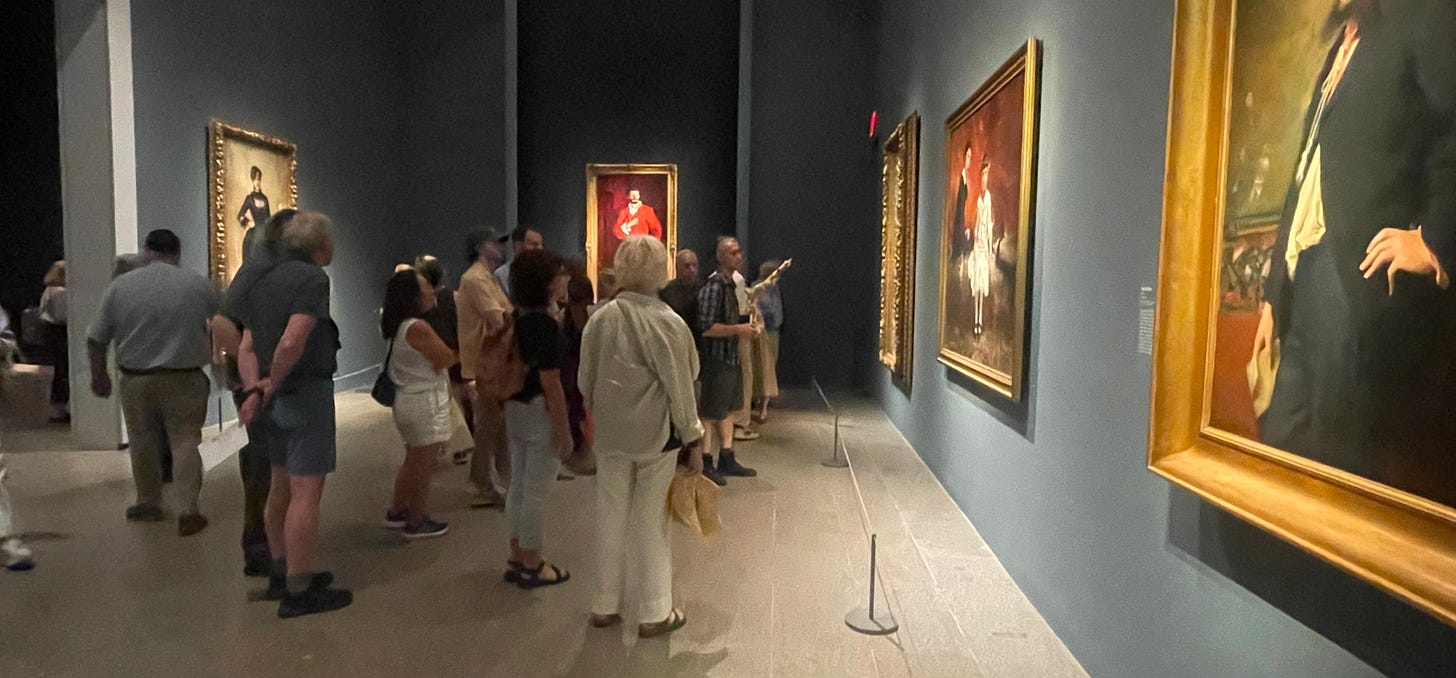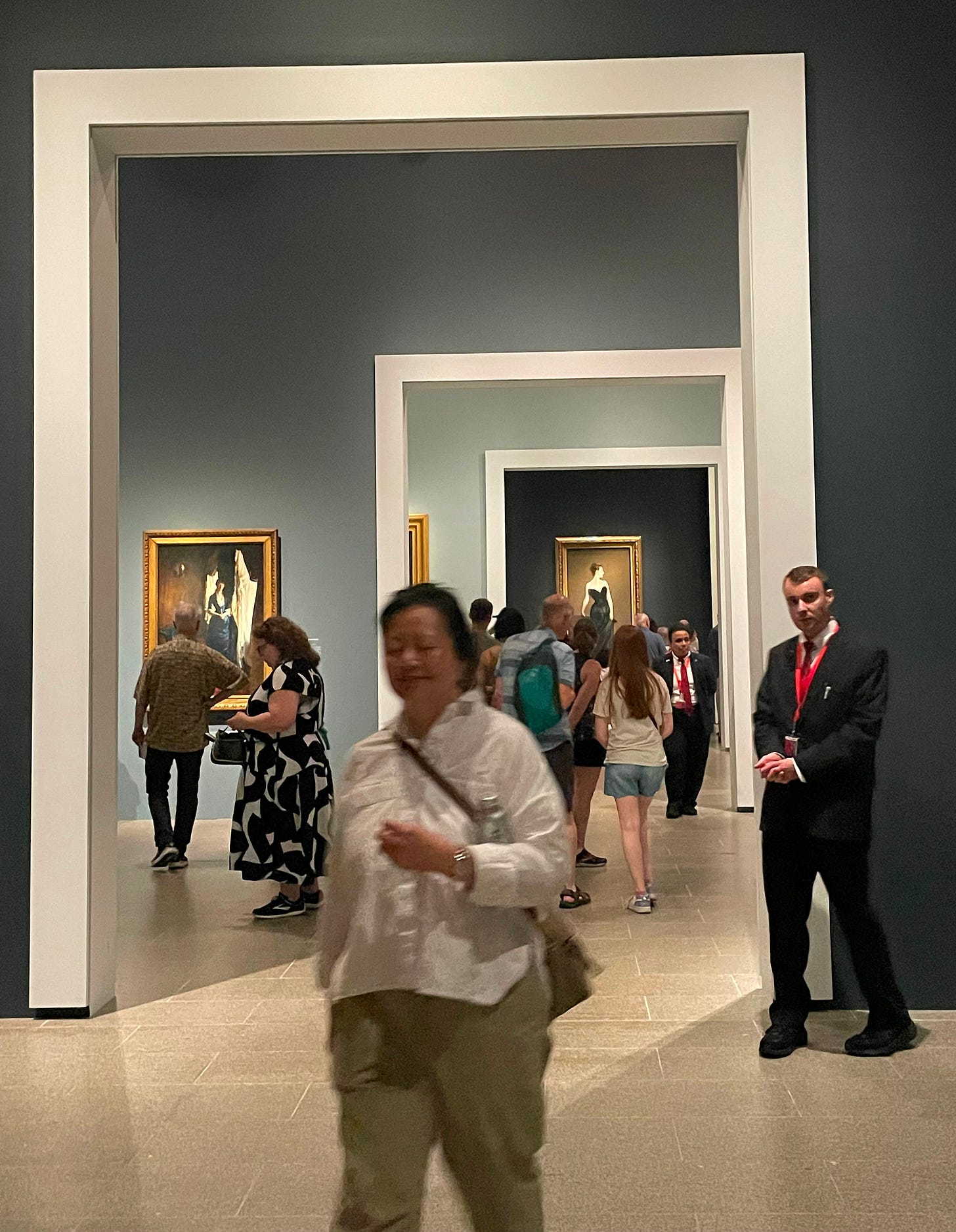Finding a Calling (And Holding Onto It)
What John Singer Sargent teaches us about How to Human
When Virginie Amélie Avegno Gautreau posed for John Singer Sargent, she thought she was sitting for a portrait. Instead, she became the center of a scandal that would define both their lives. The painting we now know as Portrait of Madame X caused such an uproar at the Paris Salon that Gautreau's mother begged to have it removed, fearing for her daughter and family’s reputations.
I thought about Gautreau's story as I walked through the Sargent & Paris exhibition at the Metropolitan Museum of Art (closing August 3, 2025—please go if you can!). I'm not an art historian or critic, but this exhibit reveals a lot about How to Human. Because everyone—not just artists—can learn to find themself and then hold onto that self. But it’s harder than we think.
Artists Find Themselves and Then Hold Onto That Self
Retrospectives offer something you can't get from art books or online galleries: the chance to witness artistic evolution in real time and space. Moving through the rooms chronologically, there's usually a moment when you turn a corner and suddenly recognize the artist you know. No matter how good copies and studies of other artists are, there’s an obvious moment when an artist becomes themselves.
It's easy to forget that artists have to find themselves. The artistic identity the world eventually recognizes isn't there from the beginning—it has to be developed through practice, study, reflection, and many failures. A retrospective traces that journey work by work in a physical space you can walk through.
But artists don’t just find their artistic selves. They have to hold onto it. For all the genius required to discover an artistic identity, it takes another kind of genius to retain it when critics, the public, and buyers pressure you to do something different. It requires a strong connection with the self to ignore them and stay the course.
Learn to Recognize Your Haters So You Can Ignore Them
Which brings us back to Madame X. The painting we now appreciate for its sensuous elegance and technical mastery initially provoked a scandal. Sargent & Paris displays contemporary reviews, and they're remarkably consistent in their pearl-clutching. Critics obsessed over Gautreau's bare shoulders and arms, calling the (fully clothed) woman's pose indecent. They questioned her morals and, by extension, Sargent's own morals and taste.
One reviewer wrote that the the overwhelming response was a sarcastic, “Ah, here is 'the beauty'!' 'Oh how horrible!” “We regret to say that Mr. Sargent has produced the worst, most ridiculous, and most insulting portrait of the year,” another critic wrote. Sargent eventually repainted her dress strap—originally shown slipping off her shoulder—back into place to calm the furor.
Reading these comments today, they sound absurd but dishearteningly timeless. Questioning women's sexual propriety has always been a first line of attack when women challenge convention. Walking through other galleries at the Met, you'll find this pattern repeated across centuries—critics responding to paintings of women with sexual slurs rather than anything meaningful.
This isn't just about art or gender. Critique of any new idea—in art, science, business, or politics—is often unrelated to the actual matter at hand. If you're someone with ideas, you need to recognize the difference between haters and serious criticism. Serious criticism engages with your work on its merits. Everyone else is just threatened by new ideas.
Taking haters seriously will send you seriously off course. Instead, learn to identify how your field communicates its version of pearl-clutching. Because recognizing and ignoring haters is a superpower.
Most Things That Look Effortless Are Not
Part of Madame X's enduring appeal is its apparent effortlessness. There's not a wasted brushstroke or a drop of unnecessary paint. The unconventional beauty of the portrait seems like it was accomplished by a prodigy.
But the exhibition reveals the enormous effort behind this effortlessness. Surrounding the finished portrait are dozens of preparatory works: pencil sketches, oil studies, and detailed drawings of Gatreau’s hands and face. Sargent spent months observing and sketching Gautreau before he attempted the final painting.
Usually, we see masterpieces alone on the museum wall, with all of the preparatory work out of sight. This creates the misleading impression that artists are fundamentally different from the rest of us—that they create things instantly and without struggle.
This illusion extends beyond art. Impressive achievements look effortless precisely because the effort is hidden or ephemeral. Musical rehearsals disappear. Conversations that shape ideas go unrecorded. Failed experiments get deleted. Business plans get rewritten dozens of times before anyone sees them. Rough drafts, false starts, endless practice all vanish, leaving only the polished result.
Whenever something strikes you as effortless, that's your cue to go looking for the hidden work behind it. The curator’s decision to show Sargent’s process alongside the finished Portrait of Madame X is a reminder that very little that looks effortless actually is.
The Art of Finding Your Calling
Wandering among Sargent's portraits, I noticed Sargent visibly arrives at a style in which he is doing exactly what they're meant to do. There is a joy and vitality to his painting that is transcendent and inspiring.
Twenty-odd years into my working life, I've started to notice that some people have jobs that deplete them while others seem to have boundless energy for their work. The difference isn't always money or status—it's whether they've found their calling.
Just as retrospectives let us witness artists discovering who they are and what they're meant to be doing, our current moment offers unprecedented ways to watch people find their callings in real time. Social media platforms like LinkedIn and Substack let people describe their professional self-discovery.
You can earn good money doing work that nevertheless makes you poorer by depleting your joy and energy. Or you can do the things that renew and energize you—and increasingly, find ways to make that sustainable. One of the incredible things about the monetization offered by platforms like TikTok, YouTube, and Instagram is that it lets people pursue their calling (Kayla Cook trying on frothy wedding dresses, The Vinteagarian’s slow living housekeeping) without being starving artists.
My calling is connecting with people through ideas—my own, theirs, ours— especially about How to Human and what people can accomplish together. That's the thread running through everything I write and create.
But I’m thinking about a TikTok account where I sample cake and look at art.
If you enjoyed this non-expert art appreciation, you might like my piece about the Rothko retrospective at the National Gallery of Art last spring.






“Absurd but dishearteningly timeless” is a terrific phrase.
This is a beautiful essay, Lura!! And I think I may have just seen, in the last episode of "The Gilded Age", their fictionalized version of Sargent finding his way in painting the daughter of the robber baron and his wife in such a way--a young woman trying to marry for love, but having these plans thwarted by her mother's push to have her marry for power and status.